![]()
The world's highest quality Sudoku puzzles straight to your website.
- 10 rated Sudoku puzzles and solutions per day - that's around 300 per month!
- Sudoku print function
- Messages for correct and incorrect solutions
- Includes help and techniques on solving Sudoku puzzles
- Extensive Sudoku archive
- Synchronise to your time-zone
- Easy and quick to setup, only basic HTML skills required
- PHP based, no database required
- Created server-side: integrates directly into your site
- Search-engine friendly, local content counts towards your website updates
- Banner free option available
- Game appearance is easy to adapt - stylesheet based design
- Payments accepted monthly, quarterly or yearly by PayPal, NOCHEX and Moneybookers
We provide Sudoku for many leading newspapers around the world. This is your chance to give your visitors the best Sudoku available.
Order now to get a Sudoku Feed on your website. A FREE demo version is now available for testing purposes.
Sudoku Help
How to play Sudoku
Complete the grid so that every row, column and every three-by-three box contains the digits 1 to 9. Solve the puzzle by logic and reasoning alone, there is no maths involved.
Simple solving techniques
All correctly formed Sudoku puzzles are solvable using logical solving techniques. The majority of puzzles can be solved using just one key technique.
As you know, the numbers from 1 to 9 must be placed once in every block. Using this knowledge, one can attempt the easiest technique: identifying a unique number to go in each block in the grid.
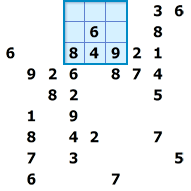 Figure 1
Figure 1
Here, you can see the highlighted block has 4 out of 9 squares present. Generally, it at the beginning it is wise to choose blocks that are more complete: these often lead to some easy squares to solve.
Look along to the blocks to the left, right and below. Scan for any of the numbers: 1, 2, 3, 5 or 7 that have yet to be placed in this block.
You should be able to spot a 3 to the right, eliminating the possibility of another 3 in the top row.
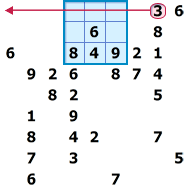 Figure 2
Figure 2
If you look down from this block, there is a second 3 allocated to the first column in the block.
Now, both the top row and the first column of the block already contain a 3. With the row and column eliminated, there is only one square remaining for the 3 in the block. You can now place the 3 as shown below.
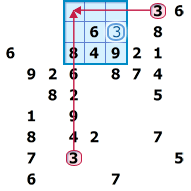 Figure 3
Figure 3
This method is relatively easy, provided you can identify good numbers to search for.
Continuing with the same method, there is an easy 6 in the centre left block.
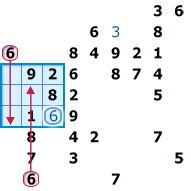 Figure 4
Figure 4
The next method is very similar as it utilises the same technique, but this time for rows and columns.
The Sudoku has several near-complete rows and columns. Pick one and identify the numbers that are missing.
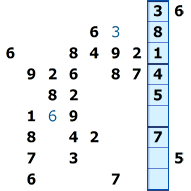 Figure 5
Figure 5
In this column, there is space for a 2, 6 and 9. However, the 6 can only lie in one of the 3 available squares as there is a 6 to the left of the other remaining gaps in the column.
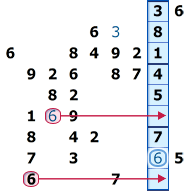 Figure 6
Figure 6
Generally, it is a good idea to focus initially on the same number. In the past example, you can see that the first 6 lead directly to finding the 6 in the column.
Continuing along this line, it is easy to spot another 6 in the block above.
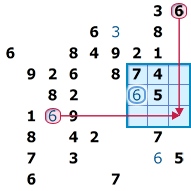 Figure 7
Figure 7
On this occasion, you can place the final 6 in the bottom centre block. Usually, it would not be possible to place all the remaining numbers in sequence.
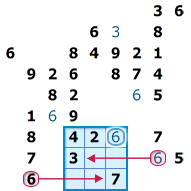 Figure 8
Figure 8
In fact, this 6 is particularly easy to spot. There are other 6s in blocks above and to the left and right. In addition, the 6 has only one remaining place for this row and column.
Figure 9 demonstrates the different techniques that can go into finding a particular value.
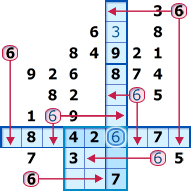 Figure 9
Figure 9
Similar techniques are used to solve this medium rated Sudoku puzzle.
© Sudoku Solver 2006


